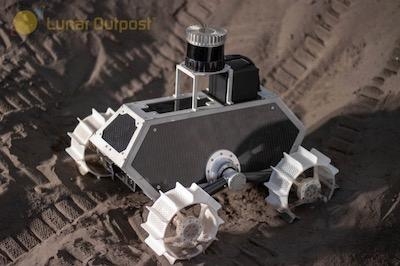Mon, Nov 19, 2018
First Moon Mission Will Be Announced Sometime Next Year
Lunar Outpost announced their Lunar Prospector designed to map the Moon's natural resources. The first Prospector was demonstrated driving and drilling in Lunar regolith simulant at the Colorado School of Mines' new lunar testbed facility in the Earth Mechanics Institute overseen by the Center for Space Resources. This event marks the first commercial Lunar Prospector publicly tested in the United States.

Evidence of valuable resources on the Lunar surface, such as water, precious metals, and helium-3 have been established by remote sensing on flyby missions around the Moon. This scientific data has been used to create resource models of the Lunar surface, which now require ground-truthing to establish optimal landing sites and plan future resource extraction operations. Groups of Lunar Outpost Prospectors will map the resources of the Moon, while autonomously navigating along waypoints and avoiding hazards. These Prospectors can also be teleoperated as necessary and can utilize NASA's Lunar Orbital Platform-Gateway concept as a center of operations.
The Lunar Outpost Prospectors are focused on providing exploration data for In-Situ Resource Utilization (ISRU). Much like the Earth-bound explorers of the past, future space missions will not be able to bring all the necessary supplies with them on their voyage. Rather, they will need to learn to use the resources available to them at their celestial destinations. The Lunar Outpost Prospectors provide early ISRU resource location, form, and distribution data to these future missions, enabling them to plan their missions more effectively and efficiently.
Each Lunar Outpost Prospector weighs 22 pounds, with 11 pounds of that mass available for additional payloads. Instrumentation from third parties is encouraged to maximize the scientific and commercial value of every Prospector mission. The Prospectors scan the Lunar surface for resources with a mass spectrometer while driving, and probe areas of high resource concentration with a drill to analyze subsurface samples. They use a space-rated 360 LIDAR system to create maps of Lunar surface features with unprecedented centimeter-scale resolution, far more detailed than maps generated from orbit. This sensor also allows the prospector to continue navigating in deep, permanently-shadowed craters, during the Lunar night, and even within Lunar lava tubes. In addition, the Prospectors will record 4K video of their operations, providing invaluable data to the resource extraction missions that follow. The Prospectors are designed to be robust, capable platforms that can be customized and mass-produced to fit a
variety of mission profiles.
Lunar Outpost will announce their first mission to the Moon in Mid-2019.
(Image provided with Lunar Outpost news release)
More News
Aero Linx: Model Aeronautical Association of Australia MAAA clubs are about fun flying, camaraderie and community. For over 75 years, the MAAA has been Australia’s largest fl>[...]
Touchdown Zone Lighting Two rows of transverse light bars located symmetrically about the runway centerline normally at 100 foot intervals. The basic system extends 3,000 feet alon>[...]
“Discovery and innovation are central to our mission at Virgin Galactic. We’re excited to build on our successful record of facilitating scientific experiments in subor>[...]
How To Get A Story On Aero-TV News/Feature Programming How do I submit a story idea or lead to Aero-TV? If you would like to submit a story idea or lead, please contact Jim Campbel>[...]
Student Pilot Reported That During Rotation, “All Of A Sudden The Back Of The Plane Kicked To The Right..." Analysis: The student pilot reported that during rotation, “>[...]
 ANN's Daily Aero-Linx (05.02.24)
ANN's Daily Aero-Linx (05.02.24) ANN's Daily Aero-Term (05.02.24): Touchdown Zone Lighting
ANN's Daily Aero-Term (05.02.24): Touchdown Zone Lighting Aero-News: Quote of the Day (05.02.24)
Aero-News: Quote of the Day (05.02.24) ANN FAQ: Contributing To Aero-TV
ANN FAQ: Contributing To Aero-TV NTSB Final Report: Cirrus Design Corp SR20
NTSB Final Report: Cirrus Design Corp SR20



